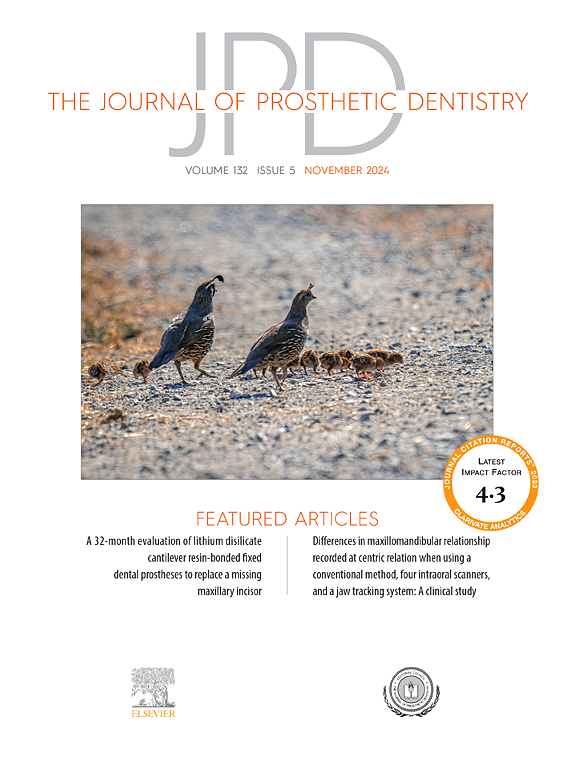Evaluation of methodologies and additive efficacy on maxillofacial color longevity research: A systematic review and meta-analysis
IF 4.8
2区 医学
Q1 DENTISTRY, ORAL SURGERY & MEDICINE
引用次数: 0
Abstract
Statement of problem
The lifespan of maxillofacial silicone elastomer-based prostheses can be as short as 6 months, primarily because of sunlight-induced color degradation. Efforts to enhance color stability have led to incorporating additives that include nanoparticles, opacifiers, and ultraviolet (UV) blockers. However, variability in testing methods and the absence of standardized protocols have led to inconsistent findings, underscoring the need for uniform testing to evaluate the color stability of these materials effectively.
Purpose
The purpose of this systematic review and meta-analysis was to assess the methodologies used in maxillofacial color longevity research and to synthesize findings on the effectiveness of additives in enhancing the color stability of pigmented silicone formulations exposed to solar radiation.
Material and methods
This systematic review, adhering to the Preferred Reporting Items for Systematic Reviews and Meta-Analyses (PRISMA) guidelines, evaluated the impact of additives on color stability under solar radiation. Searches across PubMed, Web of Science, Embase, Scopus, and Cochrane databases (up to October 2024) followed the Population, Intervention, Comparator, Outcomes (PICO) criteria, limited to English-language studies. Articles were evaluated using a modified Consolidated Standards of Reporting Trials (CONSORT) guideline and quality-assessed with the Newcastle-Ottawa Scale, with high-quality studies (scoring 6 to 9) eligible for meta-analysis. A random-effects model in the RevMan Web tool was used, with heterogeneity assessed via the I² test and results presented in forest plots with 95% confidence intervals.
Results
A lack of standardized protocols persists in methodologies concerning specimen dimensions and pigmentation formulations, despite established weathering methods for both outdoor and artificial conditions. The meta-analysis demonstrated consistent improvements in color stability with additives under artificial weathering (P<.001), while no significant improvement was observed during a 3-month period of outdoor weathering (P=.120). High heterogeneity across studies was observed, largely associated with variability in silicone pigmentation formulations.
Conclusions
Additives including nanoparticles, opacifiers, and UV blockers enhance the color stability of maxillofacial prostheses; however, the inherent stability of pigments remains a critical factor. Future research should focus on developing standardized testing methods tailored to maxillofacial applications, ensuring representativeness for prostheses and accounting for silicone formulation parameters relative to UV penetration.
颌面颜色寿命研究的方法评价及加性效果:系统回顾与元分析。
问题陈述:颌面部有机硅弹性体假体的使用寿命可能短至6个月,主要是因为阳光引起的颜色退化。提高颜色稳定性的努力导致加入添加剂,包括纳米颗粒,不透明剂和紫外线(UV)阻滞剂。然而,测试方法的可变性和标准化协议的缺乏导致了不一致的结果,强调需要统一的测试来有效地评估这些材料的颜色稳定性。目的:本系统综述和荟萃分析的目的是评估颌面颜色寿命研究中使用的方法,并综合添加剂在提高太阳辐射下有色硅树脂配方颜色稳定性方面的有效性。材料和方法:本系统综述,遵循系统综述和荟萃分析(PRISMA)指南的首选报告项目,评估了添加剂对太阳辐射下颜色稳定性的影响。在PubMed, Web of Science, Embase, Scopus和Cochrane数据库(截至2024年10月)中搜索遵循人口,干预,比较者,结果(PICO)标准,仅限于英语研究。文章采用修订后的综合试验报告标准(CONSORT)指南进行评价,并采用纽卡斯尔-渥太华量表进行质量评价,其中高质量研究(评分6至9分)符合meta分析的要求。使用RevMan Web工具中的随机效应模型,通过I²检验评估异质性,结果以95%置信区间呈现在森林样地中。结果:尽管在室外和人工条件下建立了风化方法,但在关于标本尺寸和色素沉着配方的方法中仍然缺乏标准化的协议。结论:纳米颗粒、不透明剂和紫外线阻挡剂等添加剂增强了颌面假体的颜色稳定性;然而,颜料的固有稳定性仍然是一个关键因素。未来的研究应侧重于开发适合颌面应用的标准化测试方法,确保假体的代表性,并考虑与紫外线穿透相关的有机硅配方参数。
本文章由计算机程序翻译,如有差异,请以英文原文为准。
求助全文
约1分钟内获得全文
求助全文
来源期刊

Journal of Prosthetic Dentistry
医学-牙科与口腔外科
CiteScore
7.00
自引率
13.00%
发文量
599
审稿时长
69 days
期刊介绍:
The Journal of Prosthetic Dentistry is the leading professional journal devoted exclusively to prosthetic and restorative dentistry. The Journal is the official publication for 24 leading U.S. international prosthodontic organizations. The monthly publication features timely, original peer-reviewed articles on the newest techniques, dental materials, and research findings. The Journal serves prosthodontists and dentists in advanced practice, and features color photos that illustrate many step-by-step procedures. The Journal of Prosthetic Dentistry is included in Index Medicus and CINAHL.
 求助内容:
求助内容: 应助结果提醒方式:
应助结果提醒方式:


